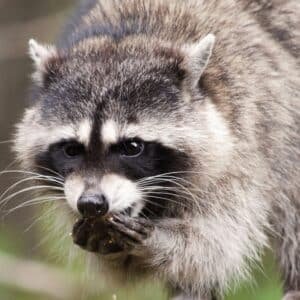
RACCOONS
FUN FACT
Raccoons have incredible dexterity and can open complex locks. Additionally, they maintain an average of seven den sites, complete with food stores, ready to relocate at any time.
Schedule Your Raccoon RemovalCall (512) 764-5804Identification
Raccoons, known for their distinctive black “masks” and dexterous front paws, are widespread across the United States. These adaptable creatures thrive in both rural and urban environments. They are omnivorous, eating everything from insects and berries to small mammals and garbage, often seeking human-provided food sources.
Signs of Infestation
- Trash Issues: Overturned or ripped garbage cans.
- Property Damage: Damage to attics, chimneys, and siding as raccoons search for entry points.
- Footprints: Small, five-toed prints in muddy areas or soft soil.
- Daytime Activity: Although primarily nocturnal, raccoons may be seen during the day if food is scarce.
- Dens: Nests in trees, attics, or under sheds.
- Excrement: Concentrated areas of raccoon droppings.
Breeding Season
Raccoon breeding occurs from late winter to early spring. After a 63-day gestation period, 3-7 kits are born in early summer. The kits are blind and helpless at birth, relying on their mother for care. Raccoon mothers are protective and may move their young to different den sites if they sense danger.
Ecosystem Role
Raccoons help control insect populations and disperse seeds, contributing to ecosystem balance. They also serve as prey for larger predators, playing a crucial role in the food chain.
Prevention Strategies
- Secure Your Trash: Use heavy-duty trash cans with tight-fitting lids or store garbage securely.
- Eliminate Food Sources: Remove pet food, birdseed, and fallen fruit from your yard.
- Seal Entry Points: Inspect and seal gaps or holes in your home.
- Use Repellents: Follow instructions for commercial raccoon repellents.
- Habitat Modification: Trim tree branches away from your roof and remove potential den sites.
- Scare Tactics: Employ motion-activated sprinklers or loud noises to deter raccoons.
Habitat and Behavior
Raccoons are nocturnal and highly adaptable, making them a common nuisance throughout Central Texas. They thrive in urban and suburban areas where food and shelter are readily available. Around homes, raccoons often take up residence in attics, crawl spaces, garages, and chimneys—anywhere they can find warmth and safety. Breeding season in Texas typically begins in late winter and early spring, with females giving birth to litters of up to five kits. Once settled, raccoons can be noisy, destructive, and pose serious health risks through their droppings and potential for disease transmission.
Prickly Pear’s Approach
Exclusion:
We begin by conducting a detailed inspection of your home to identify current and potential raccoon entry points. These openings are then sealed using durable materials such as wire mesh, metal flashing, and caulk to prevent re-entry.
Habitat Modification:
To make your property less attractive to raccoons, we address food and shelter sources—like open trash cans, accessible pet food, or overhanging branches—while also reinforcing vulnerable areas of your home that raccoons commonly exploit.
Humane Solutions:
If raccoons are already inside your home, we use humane, state-approved methods such as one-way exclusion devices and live traps to safely remove them. We take extra care during baby season to ensure young kits are handled responsibly and ethically.
Conclusion
Raccoons may be clever and curious, but having them in your home is more than a nuisance—it’s a health and safety concern. Prickly Pear Wildlife Removal offers professional, humane raccoon removal services to protect your home while treating the animals with respect. If you’ve seen signs of raccoon activity around your property, contact our team for expert help and long-term peace of mind.
